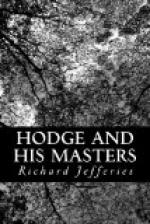In his earlier days Hodson was as close of speech as of expenditure, and kept his proceedings a profound secret. As he grew older and took less active exercise—the son resident at home carrying out his instructions—he became more garrulous and liked to talk about his system. The chief topic of his discourse was that a farmer in his day paid but one rent, to the landlord, whereas now, on the modern plan, he paid eight rents, and sometimes nine. First, of course, the modern farmer paid his landlord (1); next he paid the seedsman (2); then the manure manufacturer (3); the implement manufacturer (4); the auctioneer (5); the railroad, for transit (6); the banker, for short loans (7); the lawyer or whoever advanced half his original capital (8); the schoolmaster (9).
To begin at the end, the rent paid by the modern farmer to the schoolmaster included the payment for the parish school; and, secondly, and far more important, the sum paid for the education of his own children. Hodson maintained that many farmers paid as much hard cash for the education of their children, and for the necessary social surroundings incident to that education, as men used to pay for the entire sustenance of their households. Then there was the borrowed capital, and the short loans from the banker; the interest on these two made two more rents. Farmers paid rent to the railroad for the transit of their goods. The auctioneer, whether he sold cattle and sheep, or whether he had a depot for horses, was a new man whose profits were derived from the farmers. There were few or no auctioneers or horse depositories when he began business; now the auctioneer was everywhere, and every country town of any consequence had its establishment for the reception and sale of horses. Farmers sunk enough capital in steam-ploughs and machinery to stock a small farm on the old system, and the interest on this sunk capital represented another rent. It was the same with the artificial manure merchant and with the seedsman. Farmers used to grow their own seed, or, at most, bought from the corn dealers or a neighbour if by chance they were out. Now the seedsman was an important person, and a grand shop might be found, often several shops, in every market town, the owners of which shops must likewise live upon the farmer. Here were eight or nine people to pay rent to instead of one.
No wonder farming nowadays was not profitable. No wonder farmers could not put their sons into farms. Let any one look round their own neighbourhood and count up how many farmers had managed to do that. Why, they were hardly to be found. Farmers’ sons had to go into the towns to get a livelihood now. Farming was too expensive a business on the modern system—it was a luxury for a rich man, who could afford to pay eight or nine landlords at once. The way he had got on was by paying one landlord only. Old Hodson always finished his lecture by thrusting both hands into his breeches pockets, and whispering to you confidentially that it was not the least use for a man to go into farming now unless he had got ten thousand pounds.




